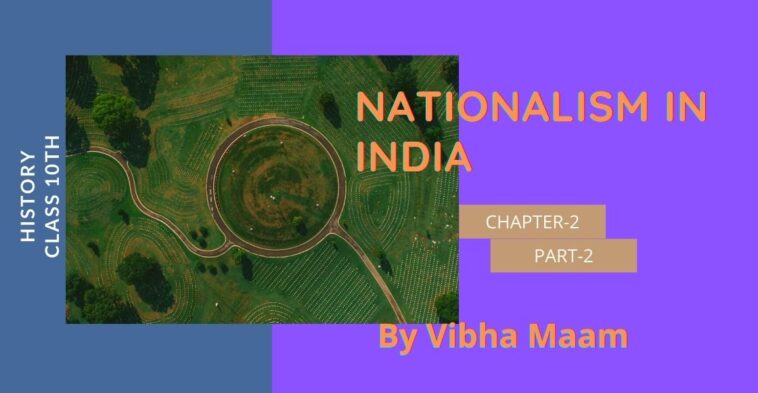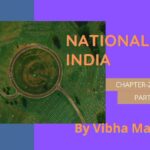Checkout handpicked notes of NCERT class 10th History Chapter 2 Nationalism in India Part 2 notes by Vibha Madam and don’t forget to share your valuable comments in the comment below to motivate our author.
Nationalism in India part 2 Notes by Vibha Maam
Towards Civil Disobedience
- After withdrawal of NCM, many argued to return to politics and contest elections to oppose government policies.
- C.R. Das, Motilal Nehru founded the Swaraj party in 1923.
- Some leaders like Jawaharlal Nehru and Subhash Chandra Bose argued agitation for ‘full independence’.
- Agricultural prices began to fall from 1926 due to worldwide economic depression and finally collapsed after 1930.
- The new Tory government in Britain constituted a Statutory Commission under Sir John Simon but in this commission did not have a single Indian member.
- The Simon commission arrived in India in 1928. It was greeted with the slogan “Simon Go Back”.
- 1929 round table conference was held but it did not satisfy the Congress leaders.
Lahore session of Congress, (Dec1929)
- Headed by Jawaharlal Nehru
- Demanded Purna Swaraj
- Declared celebration of independence day 26 January 1930
The Salt March and the Civil Disobedience Movement (CDM) 1930 (12Mar to 6th Apr 1930)
- Gandhiji sent a letter to Viceroy Irwin with 11 specific demands.
- The abolition of the salt tax was the most important demand.
- No response from Irwin
- Gandhiji started salt march with 78 followers •reaching Dandi, Gandhiji violated salt law by manufacturing salt.( 6th April 1930)
Calling off CDM (March 1931)
- People started boycotting British goods and other laws and refusing to pay taxes.
- The British took repressive action by arresting top leaders .
- The arrest of Abdul Gaffar Khan and Gandhi led to violent clashes in many places.
- Peaceful Satyagrahis were attacked, women and children were beaten, about thousands people were arrested.
- Gandhiji called off CDM in 1931.
- On 5th March 1931 Gandhi Irwin pact was signed.
Relaunch of CDM in Dec 1931
In December 1931, Gandhiji went to London to attend the second round table conference.
The government agreed to release Political prisoners. but negotiation failed , he returned back disappointed in India and relaunched the civil disobedience movement.
How participants saw the movement
Rich Peasants
In the countryside rich peasant communities became enthusiastic supporters of the Civil Disobedience Movement (CDM) but they were deeply disappointed when the movement was called off in 1931 without the revenue rates being revised. So, when the movement was restarted in 1932, many of them refused to participate.
Poor Peasants
- Unable to pay rent to landlord
- Congress not willing to support poor peasants (tenants)
- Fearing, it might upset the rich peasants. That’s why there is no active participation by poor and small peasants.
Business community
- Prominent industrialists like Puroshottdas Thakurdas, G.D Birla supported CDM
- They demanded protection against imports and exchange ratio.
- Setup ‘Indian and commercial congress’ 1921 and ‘Federation of the Indian chamber of commerce and industries’ (FICCI) in 1927 supported CDM.
- After the failure of the Round table conference, they lost their interest in the civil disobedience movement (CDM).
Workers
- Limited participation due to closeness of Congress with the business community.
- Congress was reluctant to include their demands fearing alienation of industrialists.
Women
Women participated in the movement on a large scale. They participated in protest marches, manufactured salt and picketed foreign clothes and liquor shops.
Limits of Civil Disobedience Movement (CDM)
Some social groups did not join the CDM. They were untouchables and some of the Muslim organisation.
Dalits
- B.R Ambedkar organised dalits into the Depressed Classes Association in 1930 and demanded separate electorates in a second round table conference .
- Gandhi ji opposed it as it would be harmful to integration of society.
- The Pune pact was signed between Gandhiji and Ambedkar in 1932.
- It granted reserved constituencies to dalits.
Muslims
- Alienation ( isolated) muslims from Congress
- After the decline of The non-cooperation-Khilafat movement, a large section of Muslim felt separated from the Congress.
- Mohammad Ali Jinnah formed Muslim league in 1906.
- Muslim league demanded separate electorate which Hindu Mahasabha ( M.R Jayakar) strongly opposed.
- Many Muslim leaders and intellectual now expressed their concern about the states of Muslims as a minority within India.
- They feared the culture and identity of minorities would be submerged under the domination of Hindu majority.
Cripps Mission 11 Apr 1942
- It is headed by Sir Stafford Cripps. It promised to give full self-government ( Dominion Status) once the war was over but it was rejected by the INC.
- After the failure of the Cripps mission and during the middle of the second world war, Gandhiji decided to start another phase of movement like Quit India Movement. in this he asked the British to leave the country immediately .
- Finally, this movement was suppressed by the British government but it gave a great momentum to our freedom struggle.
The sense of collective belonging
- The 20th century nation came to be seen in images of Bharat Mata .
- This image of Bharat Mata was first created by Bankim Chandra Chatterjee in 1870. He wrote Vande Mataram and Anandamath .
- Indian folk songs and folk tales sung by bards (poets or singers) played an important role in making the idea of nationalism.
- In Bengal, Rabindranath Tagore began collecting ballads, nursery rhymes and myths
- In Madras, Natesa Sastri collection of folk tales, ‘The folklore of southern India’ created nationalism in folk.
- In 1921, the Tricolour flag was prepared in Bengal during the Swadeshi Movement .
- Another means of creating a feeling of nationalism was through interpretation of history.
Conclusion
Through such movements, the nationalists tried to bind the national unity of the country. In this movement different social groups participated enthusiastically with feeling togetherness.
Don’t forget to comment in the comment section below to appreciate and motivate our author by sharing this notes with your friends you can also Contact us for any query or if you are interested in writing with us.
Use Canva for amazing images.
Stay tuned for more amazing stories, poems & articles like this.
For sponsor any article or your article you can mail us with your logo ready and details.











Thankyou mam for excellent notes
On point notes
👌👌👍
excellent 👌 notes
This notes are very short than other notes of history
Anther part of this chapter also available and that one is the part 1
So, Kindly click the link for reference
https://blogscart.in/nationalism-in-india-notes/